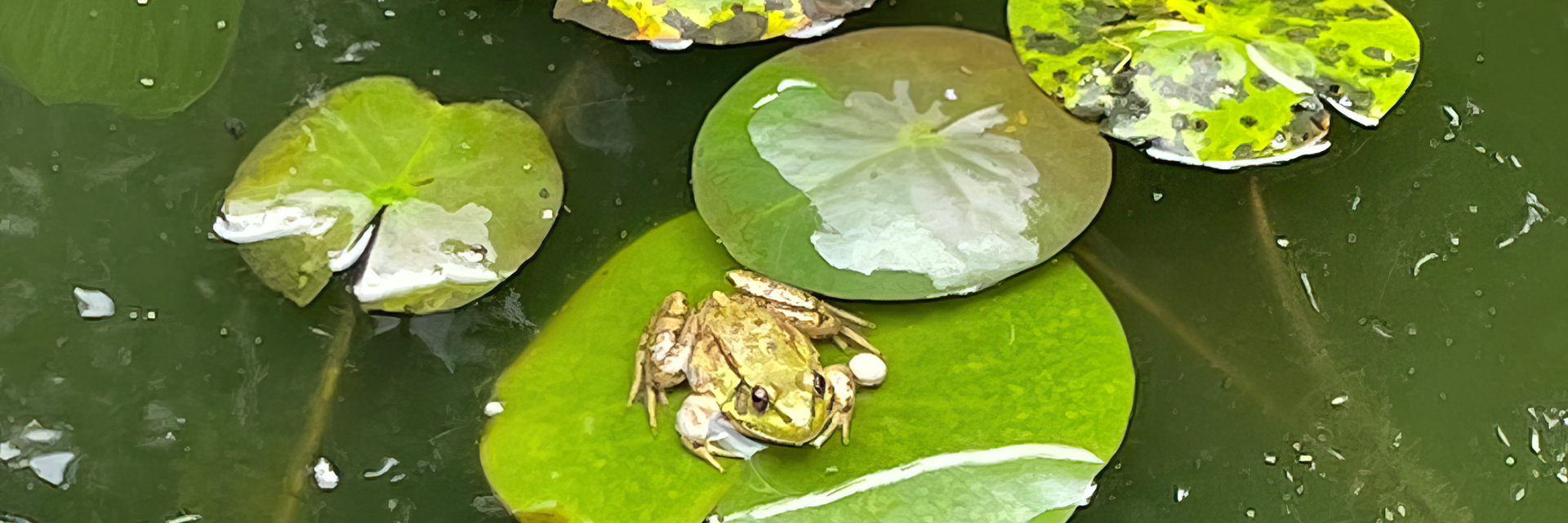I started out making ponds for fish and ended up attracting a bunch of green frogs (Lithobates ranidae), which I collectively named Fred. I came to learn that green frogs require a specific habitat – would I be able to meet their biological needs?
◊
It’s the end of August, and Club Fred is hopping. Literally.
It all started when I decided finally to act on my longtime dream of making a fish pond — a small one, but a pond nonetheless. Two, actually. After digging a hole for the plastic insert I purchased at one of those home improvement behemoths, it occurred to me that there was room for another small pond. Yay! And I could make a waterfall. Double yay! And I could get my partner, Nathan, to create a little channel to connect the ponds. Yay, cubed! So, I dug some more.
Impatient as I was to complete the job, I didn’t pay attention to the fact that the ground had a gentle slope, and I didn’t use a level to make sure that the top of each insert would be flush with the ground. It quickly became obvious that the lopsidedness, combined with the natural grade, meant the channel connecting the two ponds was more than a good idea – it was imperative!
No sooner had I begun to fill the ponds with well water, an adorable green frog (Lithobates ranidae) showed up. I was delighted! Ever since I was a kid, I’ve loved frogs. Attracted to their adorable faces and pigeon toes, I also swooned over their athletic conformation – those long hind legs folded up and ready to launch at a moment’s notice.
I named my new friend Fred. Then another one came on the scene. I couldn’t tell which was Fred and which was the new one, so I called the second one Fred as well. You can see where this is going, right? Still another and another Fred arrived – I could just hear Fred saying, kind of like Larry from that Bob Newhart show, “This is my brother, Fred, and my other brother, Fred.” Or maybe sister. After all, several Freds were pretty big compared to the others, and female frogs are typically larger than males. In any case, you guessed it. Club Fred was born.
There are loads of frog species around the world. Rhode Island, where I live, boasts multiple species, though most of my Freds were the green variety, which is considered a “common frog.”
As you can see in my photos of them, green frogs vary in size and coloring. Some green frogs are avocado or olive colored, others are closer to brown, and still others are bright green. I’ve also spotted some leopard frogs (also Lithobates Ranidae) now and then – and, yes, these aquatic frogs were named Fred, too.
Now finally, and after much toil and more than a few cold libations for fortification and reward, I had my own pond of dreams – I had built it and Freds had come.
Building the Ideal Habitat for Green Frogs (and Learning Along the Way)
Before continuing the story of Club Fred, it’s worth pointing out – if it wasn’t obvious already – that I had little idea of what I was doing. I was almost totally winging it. I did learn that shallow ponds – around 18” – could freeze in New England, which would also freeze the fish. (I only learned later what might happen to hibernating frogs.) Even if water doesn’t freeze all the way through, ponds require a vent in the top layer of ice to ensure that gasses released when organic matter breaks down wouldn’t build up, become trapped, and then kill the fish. In either case, a deicer was in order.
Yes, I wanted my fish to thrive, but I wasn’t particularly versed on how to implement it. It was Nathan who took the project in hand. He made sure we had the solar-powered bubblers to oxygenate the water, and he installed the pump (also solar-powered) for the waterfall, which the uneven terrain necessitated.
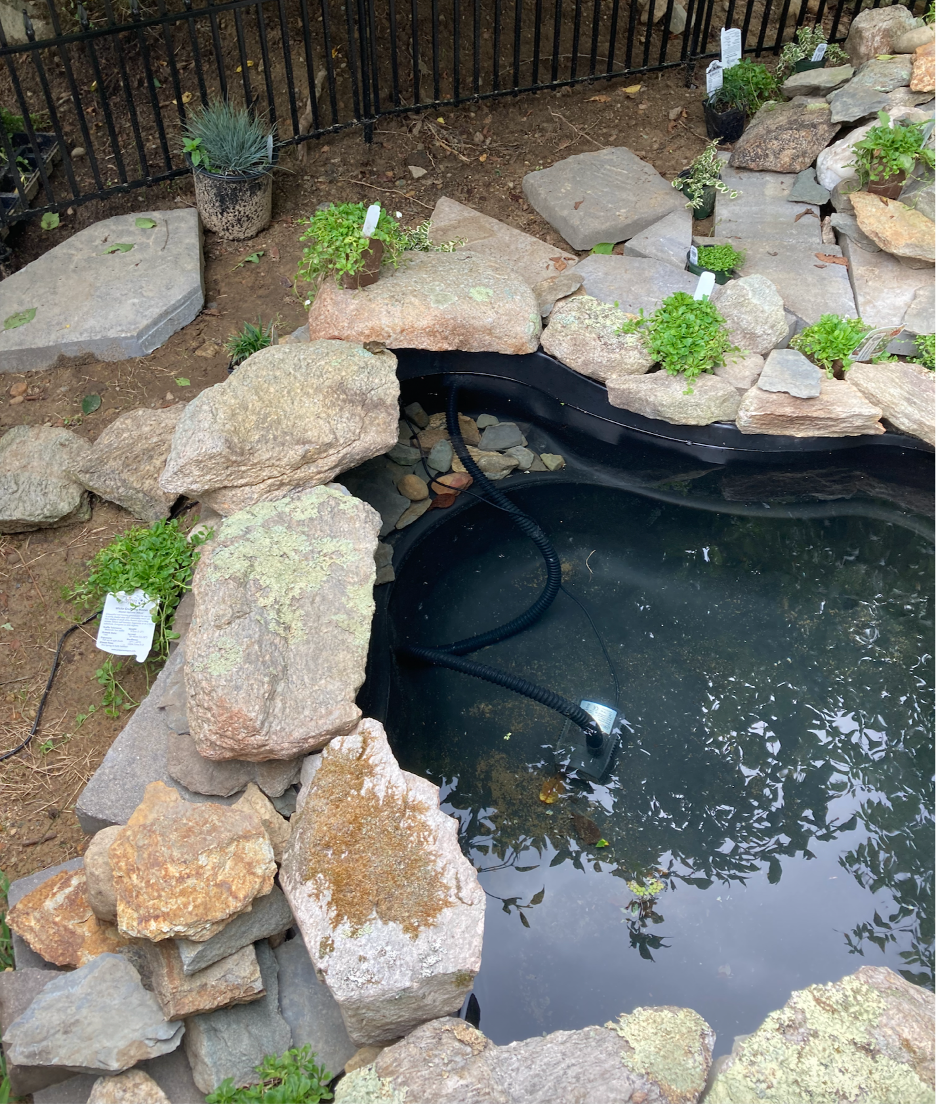
The beginning stages of what would become Club Fred.
Complicating matters was the Freds, though I happily adjusted my grand vision. For example, I shifted my focus to the landscaping side of things with frogs in mind, planting foliage and hauling rocks over from nearby piles to set around the edges of the ponds. And the water features I created in the ponds for the comet goldfish I planned to buy from a pet store (thereby saving them from almost certain death as “feeders” for larger fish and other predators) also ensured that the Freds had plenty of places to hang out in the water. What I failed to appreciate, however, is that some of the fish were actually small enough for some of the larger frogs to devour. Yes, green frogs will eat whatever they can fit into their mouths, like insects and even mice! I was too besotted with my Freds, however, to believe that some of the smallest comets had disappeared into the gaping maw of a frog’s mouth.
After several renovations both in and around the ponds, Club Fred sported a number of amenities – or, rather, Fredmenities. Underwater caves – which the frogs shared with the fish they sometimes ate – partially submerged caves, and above-ground caves in various locations offered multiple party options, pond plants gave both the Freds and the fish more places to hang out, and the surrounding foliage gave the Freds places to relax out of the water. I then fenced Club Fred so that my dogs wouldn’t have access – while building the habitat, at least one thought it was great fun to jump in and out of the water.
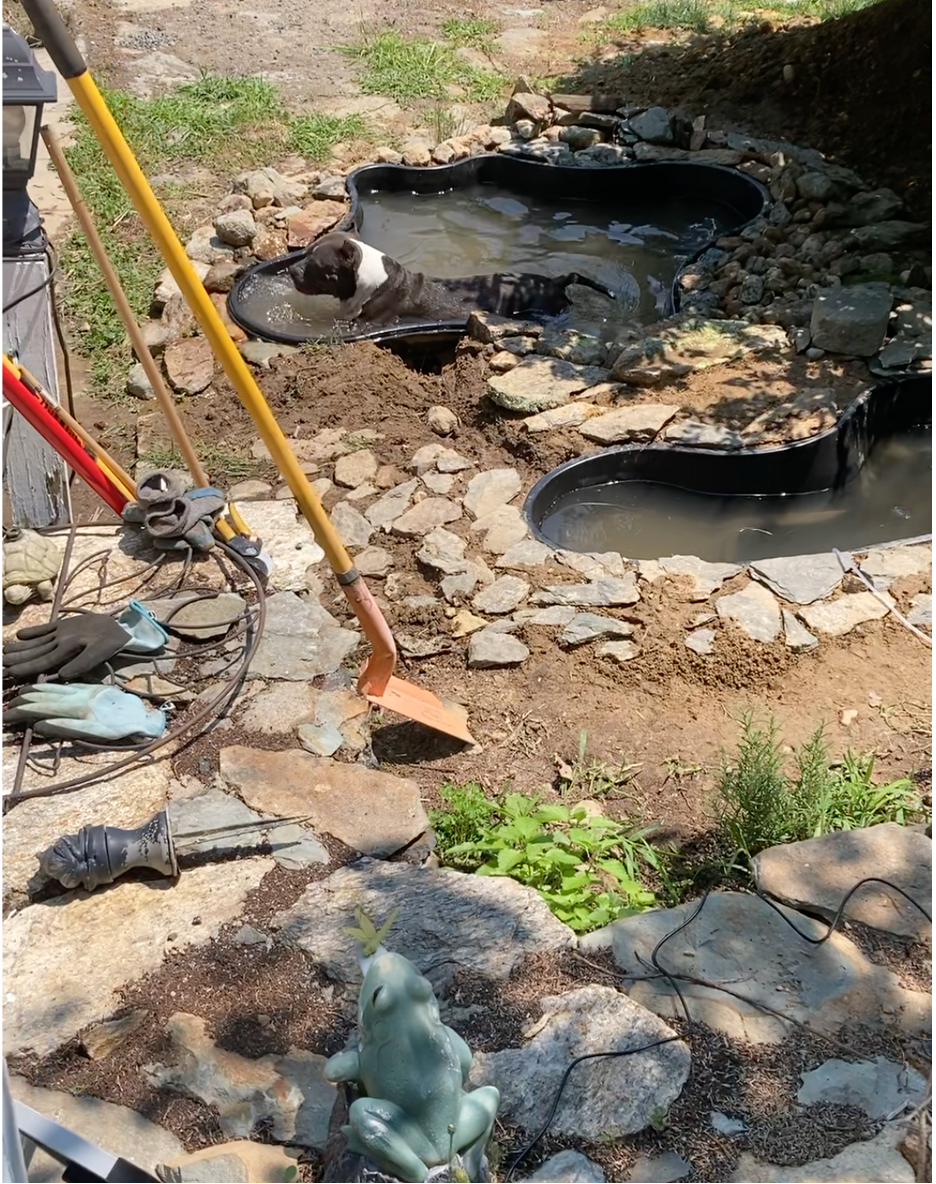
Edward “The Tadpole” Pibbles takes a dip.
As I stood back to survey the world I created, I felt pretty good about myself. A dream achieved, fish living a life that surely had to be better than pushing against an artificial current in a sterile aquarium waiting to be something’s dinner, and Freds. Freds! I was reminded of a quote from a Martin Amis novel, The Information: “He was at the time of life when – sitting in a garden or a park – he was more pleased than vexed if a bee buzzed him, flattered that anything, however briefly and stupidly, could still mistake him for a flower.”
As ridiculous as it may sound, that’s how I felt about my Freds. There was a natural pond in the woods nearby, but these frogs had found their way to me! What about the fish? Shouldn’t I have patted myself on the back about them? No. After all, they didn’t have a say in the matter, scooped out of one body of water and poured into another. But the Freds! Surely they were beckoned by my beautiful dream-made-real. Or at least that’s how I wanted it to be.
Despite the fact that aquatic frogs simply go toward any available water, including ditches and dingy puddles, I nursed my burning desire to believe they were impressed by what I built for them (and for the fish). At one point, I counted at least eight of them partying at Club Fred. I couldn’t help but be, well, flattered. Oh, hubris!
Preparing the Pond for Winter: The Hubris of the Frog Savior
As seen in the MagellanTV documentary Close to Death: Hibernation, frogs and other amphibians have a natural antifreeze – high glucose concentrations – which prevents them from freezing solid, even though they do partially freeze. But I didn’t know that. (I should have let MagellanTV teach me!) I had some hazy idea that they were self-sufficient enough just to hop away for the winter.
The fish, on the other hand, needed a diet that prepared them for winter. As the pond water temperature drops to between 50 and 60 degrees Fahrenheit, pond fish require a low-protein food that’s easily digestible. Because fish can’t digest properly in cold water, they could get sick and die if they continue eating. They should eat once every one to two days, with a gradual reduction until they aren’t fed at all when the water is consistently below 40.
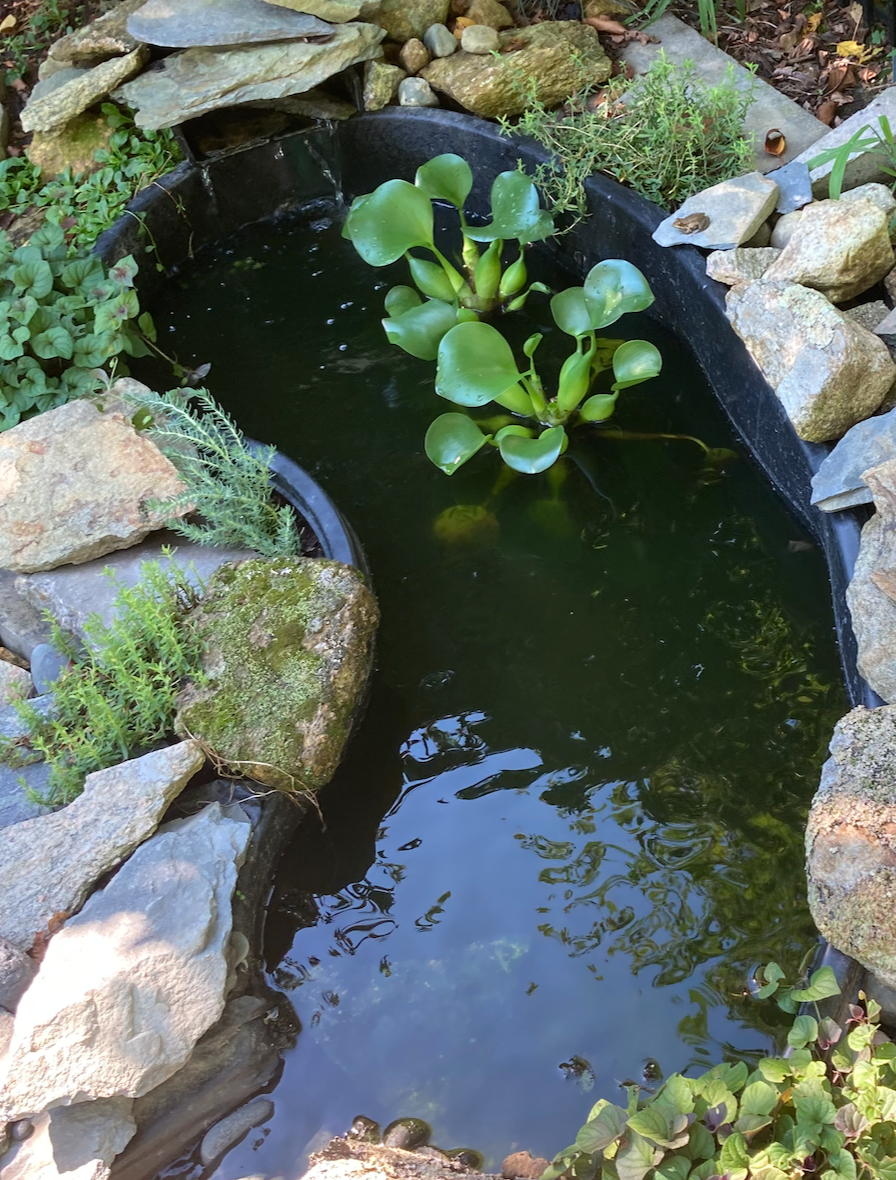
A tiny Fred enjoys the Fredmenities at Club Fred.
As the last languid days of summer gave way to autumn crispness, I prepared the fish to overwinter in their ponds. I’d read about what and when to feed them, and I got de-icers, since the ponds weren’t deep enough to withstand freezing weather that would otherwise kill the fish. And I waited for the Freds to go off and do whatever frogs do for winter.
I’d read a number of things about how green frogs hibernate, and I expected the Freds to act accordingly. A handful, however, didn’t. I was perplexed. From what I had learned, frogs in my area go into hibernation in late October. When the weather gets cold, they can live at the bottom of a body of water, maybe even slowly moving around. There is also evidence that green frogs overwinter on land, burrowing under leaves or in the nooks and crannies of downed trees. (I purposely did not get any turtles, since I knew my ponds would lack the requisite layers of mud and decomposing detritus under which they could burrow to hibernate.)
In any case, frogs and other amphibians have a natural antifreeze – high glucose concentrations – that prevents them from freezing solid, even though they do partially freeze! They can’t breathe through their noses while underwater, of course, but they exchange gas through their skin and mouth lining. So, though frogs are ectothermic – that is, cold-blooded, which means they can’t generate heat internally – they have some pretty nifty ways to withstand extreme cold. The world according to Fred biology is fascinating, indeed.
For more on frogs' fascinating natural antifreeze capabilities, check out the MagellanTV documentary Close to Death: Hibernation.
Mistakes Have Fatal Consequences, but Winter Turns to Spring
November turned to December, and then January. Four Freds continued hanging out in and around the ponds. I’d find them lounging on one of the de-icers or poking their heads out of a pond cave. I became increasingly worried. How would they survive snowstorms and days of sub-freezing temperatures? Why had they stayed out and about while the other Freds had likely moved into hibernation mode?
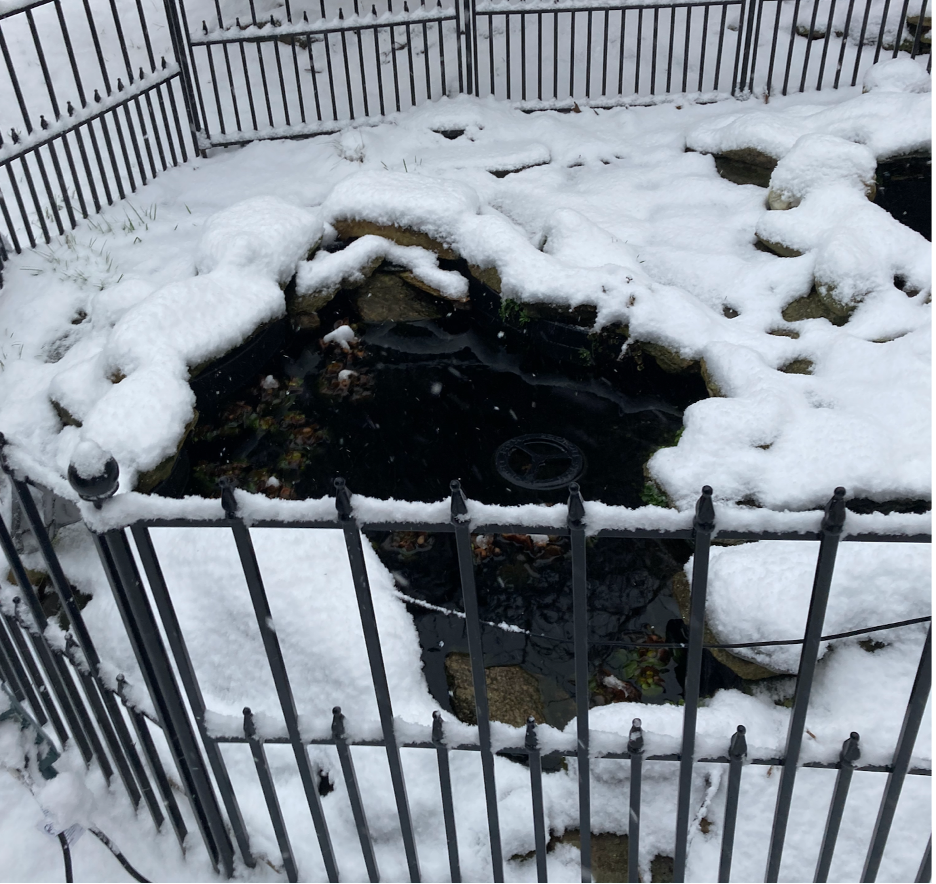
Club Fred in winter.
Before I could find an answer, a Fred turned up dead, its lifeless and bloated body floating in one of the ponds. Sadly, two more Freds followed. The fourth, thankfully, never showed up, perhaps having followed its fellow Freds into hibernation. Nevertheless, I was bereft, and figured I’d done something to contribute to my beloved Freds’ deaths. I could only hope that the fourth Fred would survive the rest of the winter.
According to the National Wildlife Federation, there are about 200 species of frog that have already gone extinct, and at least 1,000 more species are threatened. Thankfully, green frogs are not among them.
Because the ground was frozen, I couldn’t bury the bodies. So, I laid them out near the ponds and then, when the ground thawed, I buried them. I also committed myself to doing whatever I could to keep Freds from attempting to overwinter the next year. That meant waiting to set up the de-icers. I had likely started using them too early, thereby generating a sort of reverse frog-in-the-pot situation. Given that the water never got cold enough to encourage the Freds to leave for the winter, they may have slowly frozen.
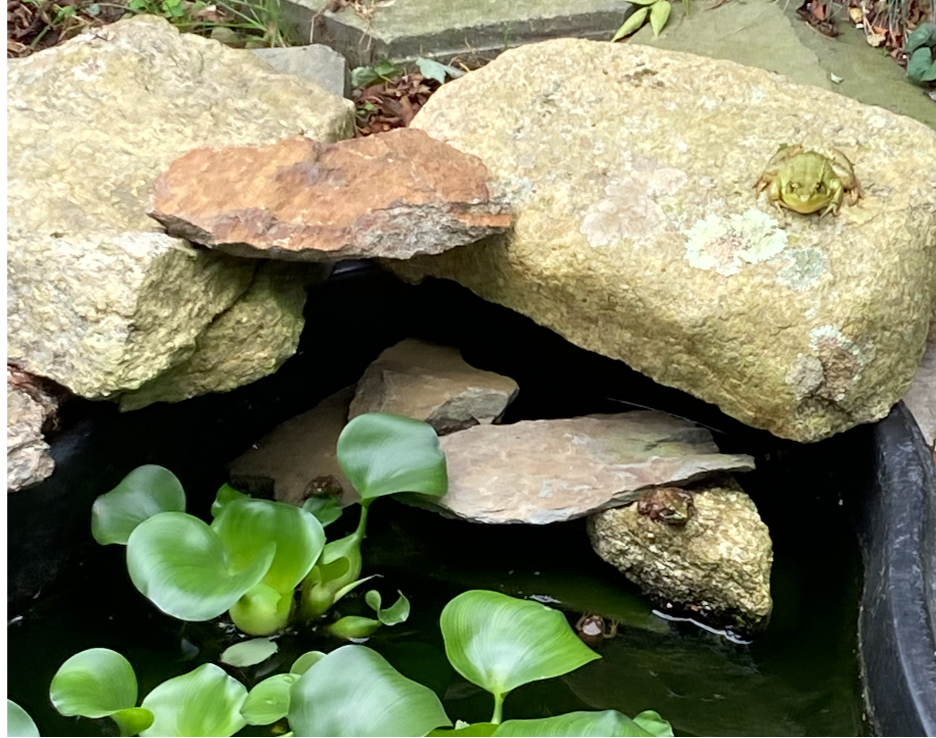
Club Fred is hopping again!
This past spring and summer brought new members to Club Fred – and maybe even Original Fred is back at the club. To date, I’ve counted 13 at one go. Yes, Club Fred is hopping again, and I am thrilled. (I’m pretty low-maintenance that way.) I am also, however, humbled. This year, I will do everything I can to ensure that the frogs overwinter successfully. I want Club Fred to hop for years to come.
Ω
Mia Wood is a professor of philosophy at Pierce College in Woodland Hills, California, a visiting lecturer at the Community College of Rhode Island, and an adjunct instructor at the University of Rhode Island and Providence College. She is also a freelance writer interested in the intersection of philosophy and everything else. She lives in Little Compton, Rhode Island.
All images courtesy of the author.
